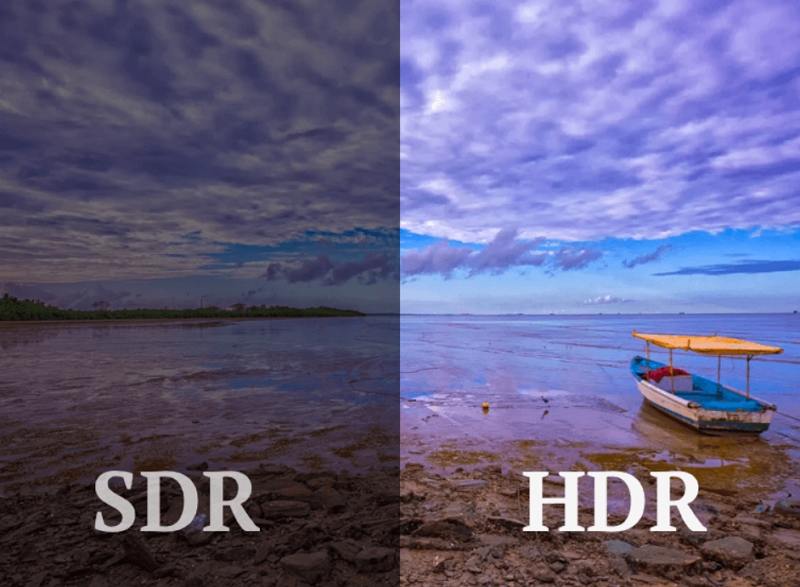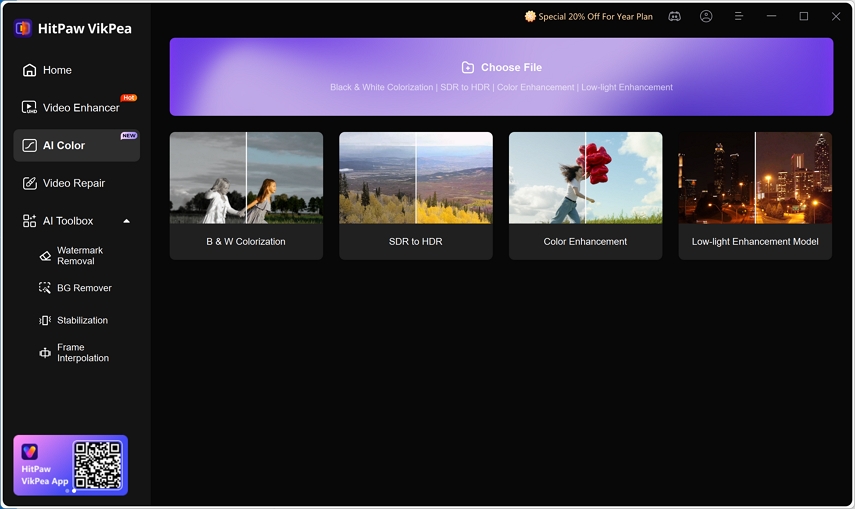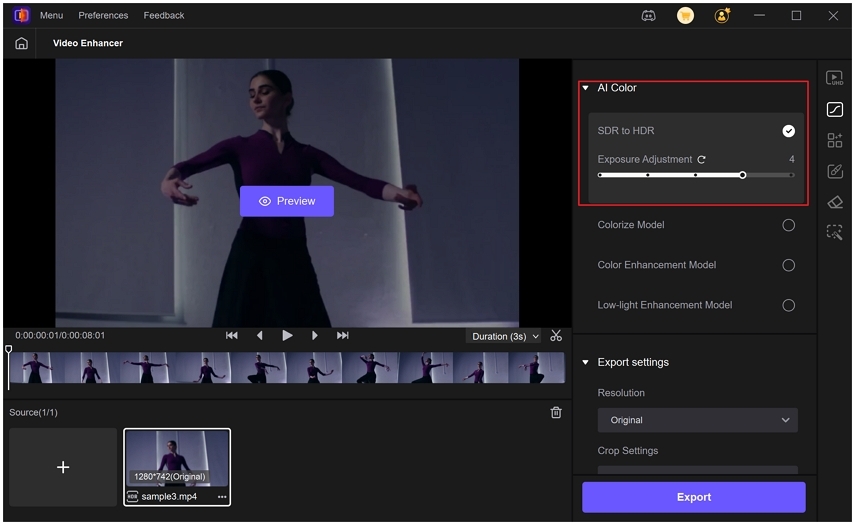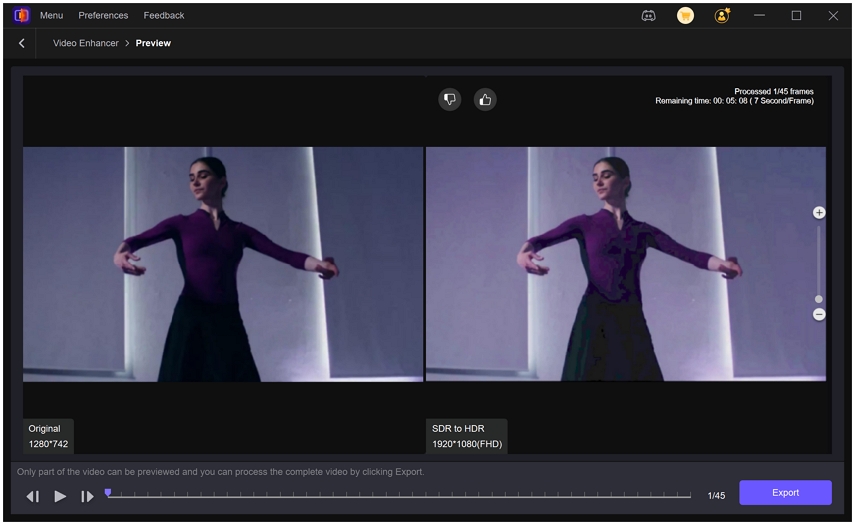Everything You Need to Know about SDR Video
Standard Dynamic Range, commonly known as SDR Video, has been the industry staple for decades. It offers a baseline of brightness, color reproduction, and contrast that works well on most devices. However, as consumer expectations for more vibrant, high-contrast visuals increase, content creators and viewers are turning their attention to more advanced formats. In this article, we explore the fundamentals of SDR Video, examine why it is losing ground, compare it with High Dynamic Range (HDR), and introduce an AI-powered method to breathe new life into your SDR footage.
Part 1. What is SDR Video?
SDR Video refers to footage encoded with a limited luminance and color range that conforms to traditional broadcast standards. It typically uses a peak brightness of around 100 nits and 8-bit color depth, which delivers reliable playback on legacy screens and devices. SDR Video is well-suited for everyday content such as web streaming, standard broadcast television, and mobile viewing. Its simplicity and broad compatibility have made it the go-to format for most video content over the past few decades.
Part 2. Why Is SDR Video Fading Now?
Although SDR Video remains compatible with most displays, viewer expectations and device capabilities have advanced. Modern screens and streaming services support larger color palettes, higher contrast ratios, and greater brightness levels that SDR simply cannot match. As a result, content producers are migrating toward richer formats that deliver more immersive experiences.
- Limited brightness range caps visual impact on high-end displays
- Narrow color depth restricts vivid, lifelike hues
- Lower contrast ratios diminish detail in shadows and highlights
- Incompatibility with modern HDR standards hinders platform support
- Viewer demand for cinematic quality pushes creators toward HDR
- Streaming services and devices increasingly optimize for HDR
Part 3. HDR vs. SDR: What's the Difference and Which is Better?
Choosing between HDR and SDR Video involves balancing compatibility and visual fidelity. SDR offers broad device support and smaller file sizes, while HDR delivers deeper blacks, brighter highlights, and richer colors. Understanding these distinctions helps creators decide which format best suits their audience and distribution channels.

A Quick Comparison Table Between HDR and SDR
Feature
HDR
SDR Video
Brightness Level
Up to 1,000+ nits for vivid highlights
Approximately 100 nits peak
Color Depth
10- to 12-bit color for smoother gradients
8-bit color
Contrast Ratio
Enhanced contrast with deeper blacks and brighter whites
Standard contrast, limited shadow and highlight detail
Color Volume & Gamut
Broader color gamut (PQ, HLG)
Rec. 709 gamut
Detail Representation
Preserves fine details in shadows and highlights
May lose detail in extreme dark or bright areas
Equipment Compatibility
Requires HDR-capable displays and pipelines
Supported by virtually all devices
File Size & Bandwidth
Larger files, higher bitrate needs
Smaller files, lower streaming requirements
Part 4. How to Convert Low-Res SDR Videos to HDR With AI?
Transforming legacy SDR footage into enhanced HDR-like visuals is now possible thanks to AI-driven tools. HitPaw VikPea leverages sophisticated algorithms to expand dynamic range, deepen color richness, and refine detail even in low-light scenes. This guide walks you through converting low-resolution SDR Video into stunning, high dynamic range content, enabling you to repurpose older clips for modern platforms without reshooting or manual color grading.
- AI-driven SDR to HDR conversion enhances dynamic range with cinematic quality
- Intelligent contrast optimization balances shadows and highlights flawlessly
- Color depth restoration brings out richer, more natural hues instantly
- Low-light enhancement recovers hidden details in dark scenes effectively
- Batch processing supports high-speed conversion of multiple videos at once
- Metadata preservation retains original settings and ensures seamless workflow
Step 1.Download and install HitPaw VikPea on your computer. Run VikPea after installing, click on AI Color and then click on SDR to HDR Model. Import the low-res videos you want to convert to HDR.

Step 2.Drag the slider to adjust the exposure level. The Exposure Adjustment slider in the SDR to HDR model lets you fine-tune the brightness level of your video after the dynamic range has been enhanced.

Step 3.Under Export Settings, choose your desired resolution. VikPea supports upscaling up to 4K or 8K. Preview the changes to see a side-by-side before-and-after comparison. Click on "Export" to transfer your color-balanced video to your computer.

Part 5. Frequently Asked Questions on SDR Video
1080p HDR offers more vivid colors and contrast despite lower resolution, while 4K SDR delivers sharper detail but limited dynamic range.
HDR enhances immersion with brighter highlights and deeper shadows; however, SDR may offer better performance on non-HDR displays.
Use SDR for broad compatibility and efficiency; opt for HDR when targeting high-end devices and audiences who value visual fidelity.
Conclusion
While SDR Video has powered the digital video landscape for years, the rise of HDR and AI-based enhancement tools like HitPaw VikPea is reshaping content creation standards. Understanding SDR's strengths and limitations, comparing it against HDR, and applying intelligent conversion techniques will help you deliver stunning, future-proof video for any platform.
Leave a Comment
Create your review for HitPaw articles












